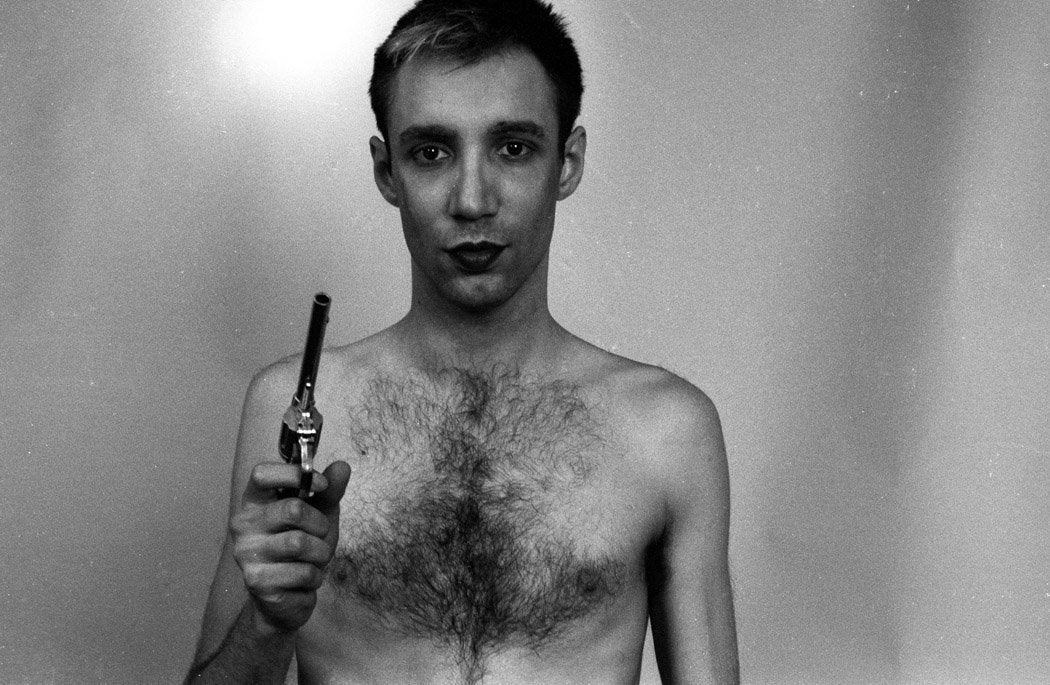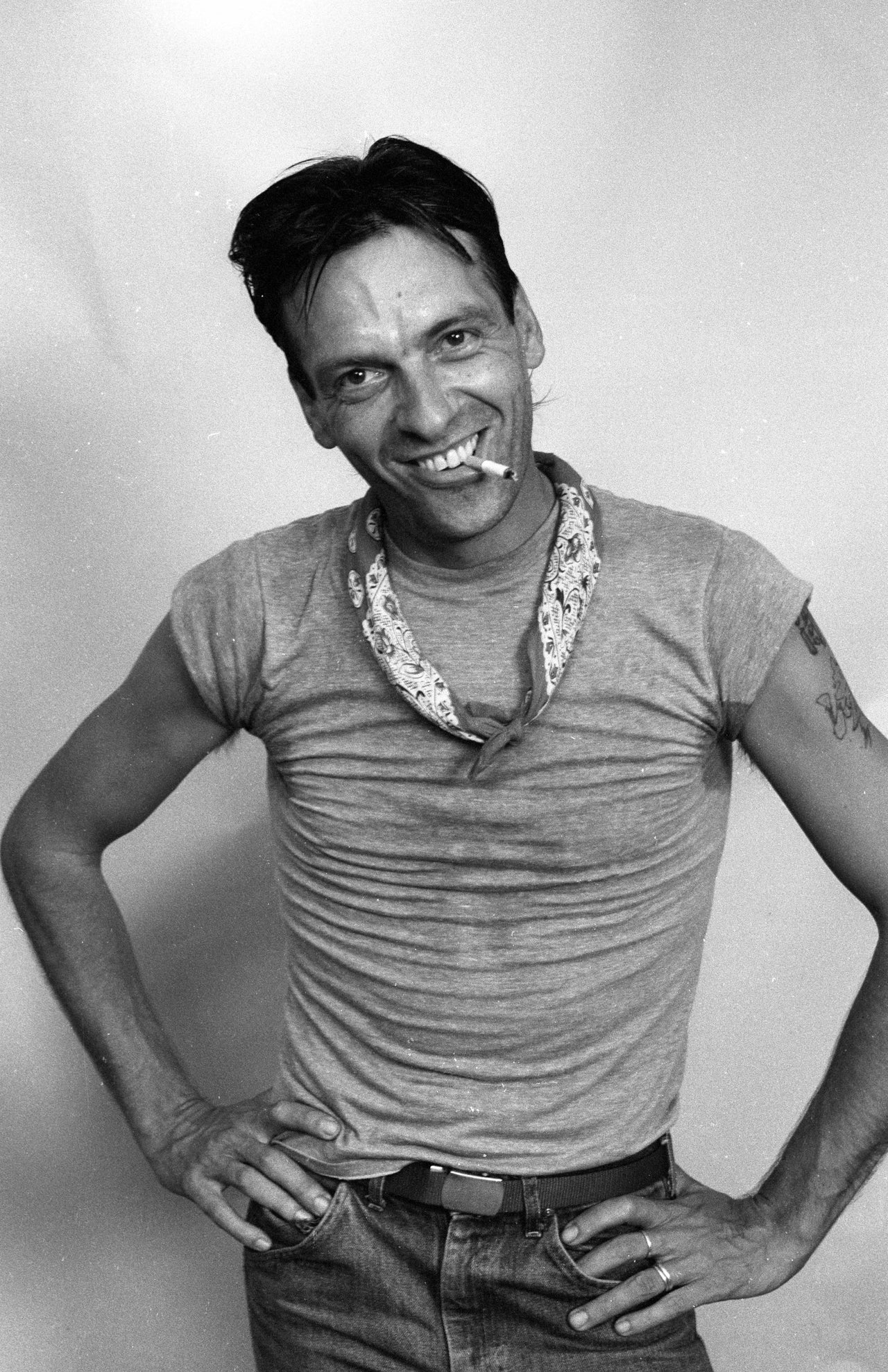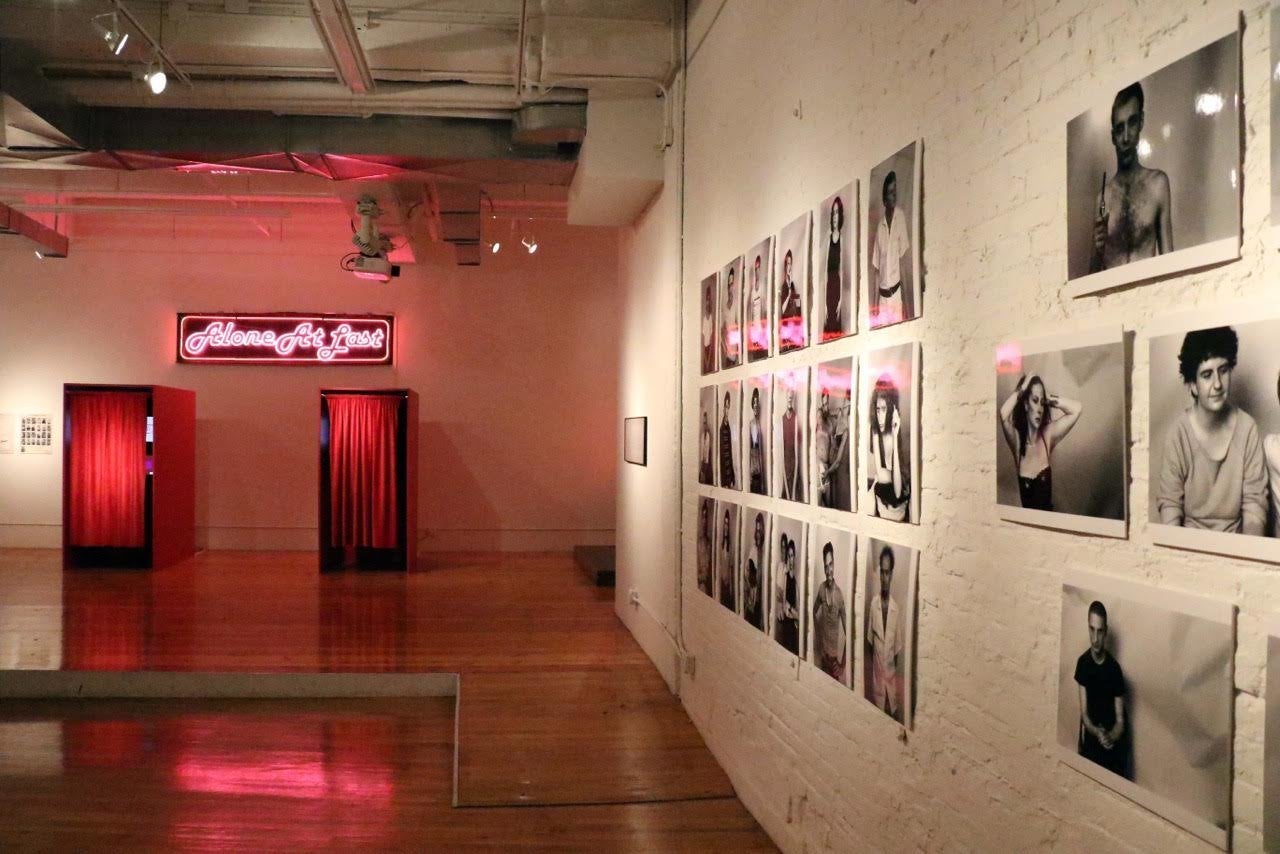Somewhere in New York City right now stand two dark booths, reminiscent of the Times Square peep show booths of yore. Above them reads a red neon sign: "Alone at Last." Enter one and your deepest fantasies will become reality -- a virtual reality.
Go ahead. Envision your fantasy seduction. Does it involve a man or a woman, or both? Do you appreciate a good striptease? A foreign accent? An innocent facade or some dirty talk? Artists Pat Ivers and Emily Armstrong developed their concept for "Alone at Last" in 1981, just before awareness of the AIDS epidemic truly spread. Both were pro-sex feminists immersed in the judgment-free sexual exploration of the time.
They also had a lot of friends in low-lit places.
Back in '81, Ivers and Armstrong enlisted a variety of nightlife personalities to perform a single ritual of seduction before the camera. Today, viewers who step into Ivers and Armstrong's modern day peep show will be privy to their temptations. Participants enter a darkened booth and answer a series of questions aimed at determining their ideal seducer. Then, on a screen, the seducer or seducers appear to perform their raunchiest invitation, all behind the red, velvet curtain of the booth.
Some performances last 30 seconds, others up to seven minutes. The raunchy screen tests offer a glimpse into an era of freedom, performance and fluidity that most Millennials can only imagine. They show fantasy on screen, not as a sugary-sweet love scene between husband and wife, nor as a dull hardcore pounding in a misogyny-addled porno, but as it is truly experienced by group of select individuals.
I reached out the artists Ivers and Armstrong to learn more.

Can you describe the sexual climate in 1981, when the project was first conceived? How has the atmosphere changed over the past 30 or more years?
Pat Ivers: It was freewheeling and wide open. I just saw the 40th anniversary "Horses" show with Patti Smith and it just reminded me how utterly unfazed people were, back then, with fluid sexuality. No one blinked, it was all about the feel of abandon, celebration and exploration. Downtown New York in late '70s, early '80s, was refreshingly free of sexism and homophobia. It was a time where everyone breathed, and felt wildly free. There was a real Dionysian feel to things but also a lot of innocence.
We had absolutely no idea of the horrors that were ahead of us once the plague of AIDS came. Now, you have safe sex and thinking twice, all good. In truth, there was darkness back then as well, but the dizzying freedom to sleep with anyone whenever you wanted to -- that's gone.
Emily Armstrong: We shot this material in the moment before AIDS was identified. Some of our friends were sick with a mysterious aliment, but no one knew what it was. Lots of sexual experimentation was going on with no judgement and no consequences. People were doing theater, making videos, designing clothes, playing music, dancing and DJing in clubs. Participation was everything. So much more was going on than traditional girlfriend/boyfriend dramas. For the people who wanted it there were on-premises sex clubs, gay and straight. Cheap rents made it all possible.
But, having a huge swath of your friends suddenly die changed everything.
Can you elaborate on your identifying as pro-sex feminists? What was the dialogue surrounding pornography that led to this distinction?
EA: For me it was about being a feminist and still liking boys. I wanted to be the kind of girl that could front a band or own a store and still dig having a cute boyfriend. A women could be the sexual predator, the huntress. A feminist didn’t wait for some guy to ask her out.
PI: There was controversy among some feminists about relationships with men and pornography and what constituted oppression. We believed that freedom of sexual expression was at the very center of women's liberation and experience. So we were pro-erotic, pro-exploration, pro-power of the pussy as some called it. "Orgasm is the body's natural call to feminist politics," as Naomi Wolf more recently said. We called that early.
In a statement describing the performance, you mention the romance, desire and manipulation involved in these '70s era peep show encounters. What do you mean by manipulation?
PI: We had an expression back then, "Charm is currency." No one had any money and sometimes manipulation was a survival tactic. We recognized that as a potential element in any relationship, especially erotic ones which is always a negotiation about power. Who's on top, well you never know till you are in the moment, do you?


As far as the performance goes, how did you select your seducers? Are they actors? Real people? Do they disrobe? How far does the seduction go?
EA: Pat and I had worked in nightclubs for years videotaping punk rock bands, doing video shows and being hired as artists to create video installations. The seducers came from our circle of nightclubbing friends: musicians, artists, bartenders, poets, coat check girls and performance artists. We held open calls, asking our friends to come and seduce the camera.
Some of the seducers stripped, some danced, some sang, some told dirty stories, some told childhood memories. There is nudity and also innocence. No two seductions are the same. They are sexy, funny, raunchy and poignant.
PI: All the seducers were Downtown originals, bartenders, bouncers and doormen from clubs we frequented, musicians and poets we admired, and friends and friends of friends. Haoui Montaug, doorman extraordinaire (and one of the seducers) used to call it the Fabulous Five Hundred, the people who made the scene. We found our seducers there, through word of mouth and a flier we gave out. That was our equivalent of the Internet -- paper fliers. Did some disrobe? Of course they did. They were trying to seduce you!
How does this experience diverge from the traditional way people now engage with sex alone -- watching porn on the Internet?
EA: Back then everybody wanted to do something: have a band, perform at Club 57, read poetry, design clothes or walk in a fashion show … our seducers were comfortable performing and being out there, participating. The idea of watching porn at home alone would have been anathema to them. More likely they would have all watched the porn, wrote a musical comedy, made some outrageous costumes and performed it at the Mudd Club.
PI: It is all about context. When we created this project, it was 1981, pre-Internet, pre--Match.com, even pre-cable. I had worked with Nam June Paik and Brian Eno on video projects concerned with the manipulation of television and the nature of the medium. With this project, we wanted our seducers to shatter conventional ideas of romance and sex roles as they were being portrayed on network television and seize control of the narrative. Lots of our friends worked in what we called "the Adult Entertainment business," so for us, utilizing that visual metaphor of a peep show booth (where many of our pals actually worked) was very exciting. Conveying our own truth, not the banal cliches of pornography or popular culture but our own stories. Then compelling a viewer to take part in it and feel that power of seduction. It kind of closed the loop for us.


What do you think is one of the biggest misconceptions about sex in the 1970s?
PI: Well, it was incredibly fun, fantastically erotic, but dangerous, dark and scary at times, too. For most of us, that was the devil's deal. You cant experience the light without the dark, but with the onset of AIDS, it became very, very dark.
EA: There was a big difference between sex in the late '70s and the free love of the late '60s. Unless it was a satirical skit at the Pyramid, there were no flowers in anybody’s hair, no songs of let-the-sunshine-in. NYC was gritty and dangerous and our seducers worked around that, having the fun-est time, but always looking over their shoulders. We knew we were living on the edge.
What could contemporary culture learn from the '70s regarding desire and expression?
EA: Lighten up? But that’s easy to say with the economic pressures of contemporary culture. Today’s emphasis on gender identity has its roots in the sexual expression of the "Alone at Last" era. The easy-going fluidity of 1981, boys wearing makeup, girls dressing butch, were a preview to today's deeper gender identity exploration.
PI: Don't judge, just be. I'm starting to see a little of the language police rearing its head. It reminds me a little of Andrea Dworkin at her most extreme. I was chastised for using the word straight and gay in the project. Chill and rub up against each other and everyone relax a little. "Alone at Last" reflects a moment in time and that was how it felt.
What do you hope to communicate through the exhibition?
PI: Being in the moment, being open to any experience, but I guess now, bring a condom in your back pocket.
EA: Me and Pat’s work is all about capturing the culture of a time, as we do in one of our other projects, the GoNightclubbing Archive which includes 115 punk band performances from 1975 to 1980. We followed Woody Guthrie’s advice: "The best way to get to know any bunch of people is to go and listen to their music."
"Alone at Last" captures a cultural moment, the blink of the eye before AIDS decimated NYC’s creative downtown community. The seducers are deliciously relaxed, whether stripping or telling a funny raunchy story. The piece captures the free-wheeling, no-hassle, creative and sexual freedom of 1981.
"Alone at Last," a feature of the GoNightclubbing Archive, runs at Howl! Happening: an Arturo Vega Project until Dec. 6.

Also on HuffPost:

